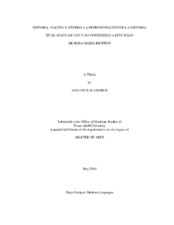| dc.description.abstract | The novel, as a genre, has been nourished since its inception by history. In this vein, literary production in Latin America has not been an exception. From the time of the conquest to the beginnings of the republican era, writers have seeded their narrative with their own lives and experiences. The emancipation of the Spanish colonies in America markedly changed the historical, political, economic and social framework of the colonists who, as writers, were the period?s strongest witnesses. The new American nations, in some cases, populated their histories with fiction, when the fiction meshed with the socio-political agenda. Some of the topics covered by this type of writing included mestizaje and social caste, topics that reinforced national utopian projects. The two historical works analyzed in this thesis present characteristics of 19th century romantic novels, especially El atuad de uso. Theories of the historical novel proposed by Gyorgy Lukacs, Anderson Imbert, Seymour Menton and Jose de Pierola form a foundation for this research and analysis. To demonstrate the relationship between the new nations and the romantic novels of the 19th century, this work draws on the research of Doris Sommer. The theory of narrative and historical representation proposed by Hayden White serves to clarify the idea of history and fiction in literature. The works of Michel Foucault, Simone de Beauvoir and Lucia Guerra-Cunningham helped capture the representation of woman throughout history.
The two novels studied in this work may be categorized as historical novels since they are anchored in real historical events. The historical representation of the characters follows loosely the model used in the 19th century. Throughout these novels background topics like mestizaje, social castes, and the role of women in the era serve as a realistic backdrop. | en |


